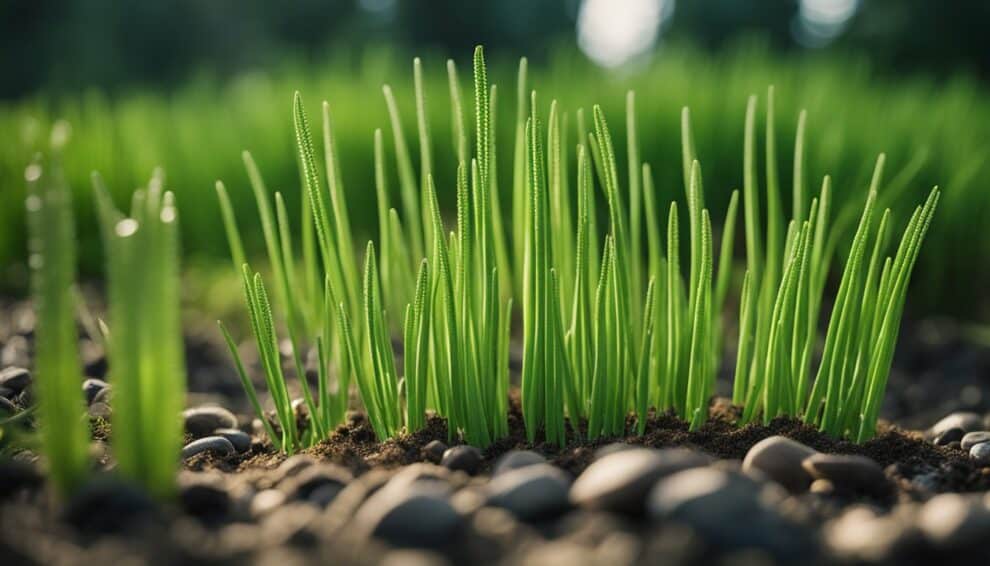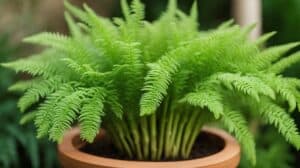Equisetum hyemale, commonly known as the horsetail plant, is a unique and fascinating plant that has been around for millions of years. With its distinctive appearance and ability to thrive in a variety of environments, it has become a popular choice for gardeners and landscapers alike. In this article, we will explore how to grow and care for Equisetum hyemale, so you can enjoy this beautiful plant in your own garden.

Horsetail plants are known for their tall, slender stems that resemble the tail of a horse. These stems are actually hollow and contain silica, which gives them their rough texture and durability. Horsetail plants are also known for their ability to grow in wet environments, making them an ideal choice for water gardens, ponds, and other aquatic settings. However, they can also be grown in drier conditions, as long as they are provided with enough water and sunlight.
Growing Equisetum hyemale is relatively easy, but there are a few things to keep in mind. This plant prefers moist, well-drained soil and partial to full sunlight. It can also tolerate a wide range of temperatures, from freezing to hot and humid. With a little bit of care and attention, you can enjoy the beauty and unique characteristics of the horsetail plant in your own backyard.
Understanding Equisetum Hyemale
Species Overview
Equisetum hyemale, commonly known as the horsetail plant, is a perennial plant that belongs to the Equisetaceae family. It is native to North America and can be found in wetlands, marshes, and along riverbanks. The plant has a unique appearance with its jointed stems that resemble the tail of a horse. The stems can grow up to 4 feet tall and have a diameter of about 1/2 inch.
The horsetail plant is a non-flowering plant that reproduces through spores. It has a deep root system that allows it to absorb nutrients from the soil, making it a useful plant for soil retention and erosion control. The plant is also known for its medicinal properties and has been used for centuries to treat various ailments.
Historical Significance
Equisetum hyemale has been used for various purposes throughout history. Native Americans used the plant for medicinal purposes, including treating wounds, kidney problems, and tuberculosis. The plant was also used to make tea and was believed to have diuretic properties.
In ancient times, horsetail was used to polish metal due to its high silica content. The plant was also used as a scouring agent for cleaning pots and pans. In addition, horsetail was used in traditional Chinese medicine to treat various ailments, including respiratory problems, arthritis, and skin conditions.
Overall, Equisetum hyemale is a unique and useful plant with a rich history and numerous benefits. By understanding its characteristics and historical significance, gardeners and nature enthusiasts can appreciate the plant’s beauty and value.
Cultivation Guidelines

Ideal Growing Conditions
Equisetum hyemale, commonly known as the horsetail plant, is a hardy perennial that grows well in a variety of conditions. However, for optimal growth and health, it is important to provide the plant with the right growing conditions.
Horsetails thrive in well-draining, moist soil with a pH range of 6.0 to 7.5. They prefer full sun to partial shade and can tolerate temperatures as low as -40°F (-40°C) and as high as 100°F (38°C). It is important to note that horsetails can become invasive, so it is best to plant them in a contained area or in a pot.
Planting Techniques
Horsetails can be grown from seeds or rhizomes. If planting from seeds, sow them in the fall or early spring. Rhizomes can be planted anytime during the growing season. When planting, make sure to bury the rhizomes just below the soil surface. If planting in a pot, use a well-draining potting mix and make sure the pot has drainage holes.
Watering and Nutrient Requirements
Horsetails require consistent moisture to thrive. They can tolerate periods of drought, but extended dry periods can cause the plant to go dormant or die. Water the plant deeply once a week, or more frequently during hot, dry weather.
Horsetails do not require fertilizer, as they are able to obtain all necessary nutrients from the soil. However, if the plant is growing in poor soil, a balanced fertilizer can be applied once a month during the growing season.
By following these cultivation guidelines, you can successfully grow and maintain a healthy horsetail plant.
Maintenance and Care

Pruning and Managing Growth
Equisetum hyemale, commonly known as the horsetail plant, is a low-maintenance plant that requires minimal pruning. However, to maintain its shape and prevent it from becoming invasive, it is recommended to prune it once a year. The best time to prune horsetail is in late winter or early spring before new growth appears.
To prune horsetail, simply cut back the dead or brown stems to the ground level using a pair of sharp pruning shears. Be sure to wear gloves when handling the plant as its stems are abrasive and can cause skin irritation.
To manage the growth of horsetail, it is recommended to plant it in containers or in an area where its spread can be controlled. Horsetail can be invasive if left unchecked and can quickly take over a garden.
Pest and Disease Management
Horsetail is generally pest and disease-resistant, making it an easy plant to care for. However, it can be susceptible to fungal diseases if overwatered or planted in poorly-draining soil. To prevent fungal diseases, ensure that the soil is well-draining and avoid overwatering the plant.
Horsetail can also be affected by spider mites, which can cause yellowing leaves and stunted growth. To prevent spider mites, regularly hose down the plant with water to wash off any pests and keep the plant healthy.
By following these simple maintenance and care tips, you can enjoy a healthy and beautiful horsetail plant in your garden.
Landscape and Decorative Uses

Equisetum hyemale is a versatile plant that can be used for a variety of landscape and decorative purposes. Here are some design ideas and companion plants to consider when incorporating horsetail into your garden:
Design Ideas
-
Water features: Horsetail is a great choice for water features such as fountains, ponds, and streams. Its tall, slender stems add a unique vertical element to the landscape and create a soothing sound as water flows through them.
-
Architectural interest: The upright, bamboo-like appearance of horsetail makes it an ideal plant for creating a modern or minimalist garden design. It can be used to create a natural fence or screen, or to add height and texture to a garden bed.
-
Container gardening: Horsetail can be grown in containers and used to add a touch of greenery to patios, balconies, and other small spaces. It looks great in tall, narrow pots and can be used to create a striking focal point.
Companion Plants
-
Hostas: Horsetail pairs well with hostas, which have broad, lush leaves that provide a nice contrast to the slender stems of the horsetail. Both plants prefer moist soil and partial shade, making them a great pairing for a woodland garden.
-
Ferns: Ferns and horsetail have similar growing requirements and make great companions in a shade garden. The delicate fronds of the ferns provide a soft, textural contrast to the rigid stems of the horsetail.
-
Grasses: Ornamental grasses such as Japanese forest grass or fountain grass can be used to complement the vertical lines of horsetail and add movement to the garden. They also provide a nice contrast in texture and color, with the soft, flowing leaves of the grasses contrasting with the stiff, upright stems of the horsetail.
Incorporating horsetail into your garden can add a unique and interesting element to your landscape design. With its versatility and ease of care, it’s a great choice for both beginner and experienced gardeners alike.
Frequently Asked Questions

What are the ideal growing conditions for Horsetail plants?
Horsetail plants thrive in moist and fertile soil, with a pH range of 6.0 to 7.5. They prefer full sun to partial shade and can tolerate a wide range of temperatures. However, they grow best in temperatures ranging from 60°F to 80°F.
How do you propagate Horsetail plants effectively?
Horsetail plants can be propagated by dividing the rhizomes in the spring or fall. Simply dig up the plant and separate the rhizomes into smaller sections, making sure that each section has at least one growing point. Plant the sections in a well-draining soil mix and keep them moist until they establish roots.
What are common issues to watch out for when caring for Horsetail plants?
Horsetail plants are generally disease and pest-free, but they can suffer from fungal diseases if they are grown in poorly-draining soil. They can also be affected by spider mites, which can be controlled with insecticidal soap.
How often should Horsetail plants be watered?
Horsetail plants require consistently moist soil, so they should be watered regularly. However, they do not like to be waterlogged, so make sure that the soil drains well. In general, they should be watered once or twice a week, depending on the weather conditions.
Can Horsetail plants grow indoors, and if so, how?
Horsetail plants can be grown indoors in a bright, humid location. They prefer a temperature range of 60°F to 80°F and require consistently moist soil. To grow them indoors, plant them in a well-draining soil mix and keep them in a location with bright, indirect light. Mist them regularly to maintain humidity.
What is the best way to control the spread of Horsetail plants in the garden?
Horsetail plants can be invasive, so it is important to control their spread. One way to do this is to plant them in containers or raised beds, which will prevent them from spreading through the garden. Another option is to install a barrier around the plants, such as a deep plastic or metal edging, to prevent their rhizomes from spreading.














